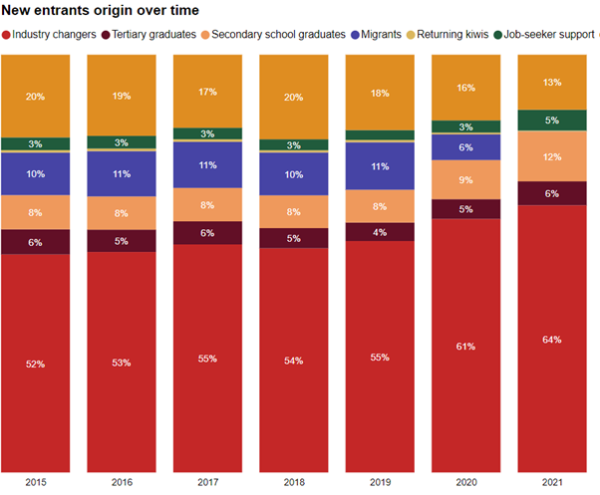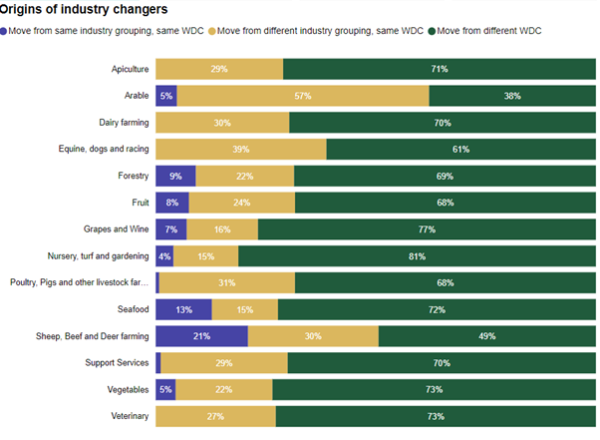Churn in the food and fibre sector
We know that border closures affected (decreased) the number of new entrants who were migrants in 2020 and 2021. The total number of new entrants during those years, 2020 (66,800) and 2021 (61,700), also decreased compared to the number of new entrants in 2017-2019 (between 74,000-77,000). This means that the proportion of new entrants who were industry changers increased over the period, though the actual number of new entrants decreased overall.

We wanted to dig down into whether these industry changers were coming from other industries within the food and fibre sector, or from other sectors, represented by different Workforce Development Councils.
Over a third of industry changers in Muka Tangata industries come from another Muka Tangata industry. In 2020 this equated to ~14,000 people.
Our analysis found that in 2020 one third (34%) of industry changers are from another food and fibre industry represented by Muka Tangata, 29% came from service industries (represented by Ringa Hora), 19% from manufacturing, engineering and logistics industries (represented by Hanga-Aro-Rau), 10% from construction and infrastructure industries (represented by Waihanga Ara Rau), 5% from community, health, education and social services (represented by Toitū te Waiora) and 3% from creative, cultural, recreation and technology industries (represented by Toi Mai). The proportion of industry changers coming from other food and fibre industries represented by Muka Tangata was higher in previous years (40% in 2017 and 2018).

In 2020, 8% of new entrants in Fruit moved from one specific Fruit industry to another. Even within groupings of industries (e.g. Fruit) people move from one specific industry within that group to another. For example, a person moving from Apple and Pear Growing to Kiwifruit Growing would be counted as an industry changer within the same industry group (Fruit), if that person had no record of working in the Kiwifruit Growing industry previously.
What does this mean?
This kind of movement means there are many new workers that bring transferrable skills and sector knowledge with them. These transitions can be advantageous for organisations/workplaces because individuals with experience in multiple industries can bring fresh perspectives and innovative solutions to challenges as well as wider sector knowledge.
Such moves can also enhance long-term career prospects. A diverse background in multiple industries within a sector can prepare individuals for leadership roles that require a broader understanding of the sector as a whole.
It's important to note that while many skills are transferrable, some roles within an industry may require specialised knowledge or certifications. In such cases, people may need to invest in additional training or education to bridge any gaps in their qualifications.
Given that most workers are coming from other jobs, many within the food and fibre sector, it is important that we can understand and recognise transferrable skills. Muka Tangata is currently working on a Food and Fibre Skills Framework project to identify and map transferrable and specialist skills. This project could help connect formal and informal learning, giving recognition for specific skills. By doing this, we can collectively make the most of the diverse skills available, ultimately benefiting the entire sector.